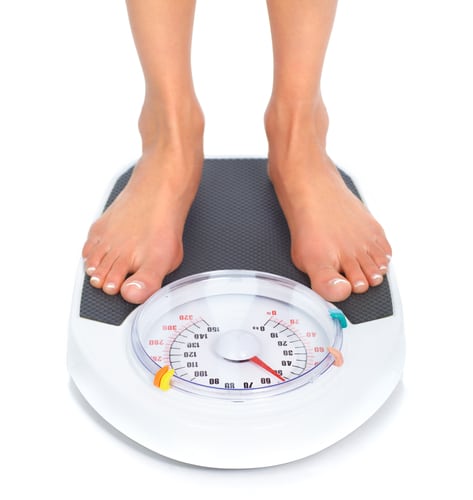
A Quick Way of Calculating a Healthy Weight
Health professionals sometimes use a formula to estimate an individual’s ideal body weight based on their height. Based on this formula, women who are five feet tall have a theoretical ideal body weight of 100 pounds. You would then multiply each additional inch in height above 5 feet by five to get a person’s approximate ideal body weight. For example, a woman 5 foot 4 inches would have an ideal body weight of 120 pounds. (100 + 4 x 5). For men five feet tall, 106 pounds is theoretical ideal body weight. For men over 5 feet, each additional inch is multiplied by six to get ideal body weight. So, a man that’s 5 foot 10 inches would have an ideal body weight of around 166. (106 + 10 x 6).
BMI: Another Approach to Gauging Ideal Weight
Another way health professionals gauge a person’s weight is by calculating their BMI or body mass index. There are BMI calculators online, like in our Workout Manager, where you can plug in your numbers and get your BMI and look at a BMI chart to see if you’re in a healthy range. BMI uses a formula based on height and weight.
Both body weight and BMI are quick ways to assess someone’s weight but both have limitations. They only take into account height and weight. There are a growing number of people, especially those who don’t exercise, who are “skinny-fat.” These people fall into the ideal range or under ideal on the BMI and weight charts, but if you measured their body fat percentage it would be high. That’s where BMI and body weight as measurements of ideal weight are limited. They tell you nothing about body composition or how much of that weight is muscle and how much fat.
The reality is an athlete with a very low body fat percentage and lots of lean muscle tissue can fall into the overweight category based on body weight or BMI. At the same time, someone with a high body fat percentage and little muscle can still be in the “ideal” range. You can’t necessarily assume you’re healthy from a weight standpoint just because you’re in the ideal range on weight and BMI charts. A 5 foot 4-inch woman that weighs 120 pounds and has 35% body fat is less healthy than a woman of the same height that weighs 132 pounds and has 18% body fat.
Body Composition Matters When it Comes to Health
A better indicator of health and fitness is body fat percentage. The most accurate ways to measure body fat is a DXA scan (similar to an x-ray and involves radiation) or air displacement plethysmography where you get into a chamber that’s sealed off. Body fat percentage can be calculated based on how much air you displace inside the chamber.
Another technique called near-infrared interactance delivers an infra-red beam of light into a muscle and measures how much is absorbed by the fat tissue. These are all accurate methods for measure body fat percentage but you can’t do them at home.
What about body fat scales? Body fat scales for home use aren’t necessarily all that accurate. They work by sending a weak electrical impulse through the body and measuring how quickly the impulse returns. The impulse moves more quickly through lean tissue as opposed to fat. The reading is affected by factors like how hydrated you are and when you last ate. Despite their lack of absolute accuracy, body fat scales are helpful for following changes in body fat percentage.
Calipers that measure skinfold thickness are a low-tech way to estimate body fat percentage. They’re reasonably accurate if you do the measurements correctly and measure under the same conditions each time.
Another Measurement of Health and Fitness
When’s the last time you measured your waistline? An old-fashioned tape measure can tell you a lot. Most importantly it can tell you your waist-to-hip ratio or WHR. WHR is one indicator of cardiovascular risk and general health as well. People who have a high waist-to-hip ratio have more visceral fat, deep waist and belly fat that’s pro-inflammatory.
To measure your WHR, measure your waist at its narrowest point. If you have a waist that bulges outwards, measure an inch above your navel. Get your hip measurement by measuring at the widest part of your buttocks. Divide your waist measurement by your hip measurement to get your ratio.
How did you score? If you’re female, your waist-to-hip ratio should be less than 0.9. Males should have a WHR of less than 0.8 to place them in the lowest cardiovascular risk category.
The Bottom Line?
Most people use the scale as an indicator of how fit and healthy, but they’re not getting the full story. If possible, know and follow your body fat percentage. Be sure your waist-to-hip ratio falls into a healthy range too. These tell you more than your body weight or BMI.
References:
Medical News Today. “What is a Healthy Weight?”
Southwestern Medical Center. “Waist-to-hip ratio may better predict cardiovascular risk than body mass index”
Related Articles By Cathe:
5 Numbers That Impact Your Metabolic Health That You Need to Know
3 Tests that Outperform BMI for Monitoring Obesity & Health Risks
3 Reasons the Scale Says You’re Heavier that Have Nothing to Do with Body Fat
How Effective Are Skin-Fold Measurements for Determining Body Fat Percentage?
Can Skinfold Calipers Accurately Measure Body Fat Percentage?
Body Weight, Bmi, Waist Size – Which is the Best Indicator of Health?

